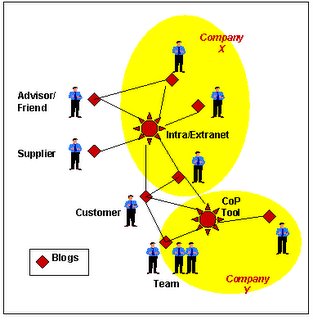Social Networking Enablement
 In a recent post, I described Social Networking Enablement as the natural evolution of Knowledge Management:
In a recent post, I described Social Networking Enablement as the natural evolution of Knowledge Management:(1) Knowledge Management vs. (2) Social Network Enablement
Knowledge Creation Strategy
(1) Submit what you know
(2) Publish your filing cabinet
Knowledge Use Strategy
(1) Re-use: Find & tailor appropriate knowledge from central repositories
(2) Qualify & Proxy: Use individuals' knowledge to qualify them as appropriate experts to converse with, and as a surrogate for that individual when they are not available for conversation
Where Knowledge Resides
(1) Large, centralized repositories
(2) Decentralized, personal weblogs (mostly)
Key Knowledge Tools
(1) Search engines, Community of Practice and collaboration tools
(2) Expertise finder, Weblog auto-publishing tool, Social software (described below)
Critical Connection
(1) People-to-knowledge
(2) People-to-people
As the table above suggests, the key technical elements of Social Networking Enablement (SNE) are business weblogs (the repositories of personal knowledge) and social software (the tools that connect people and mine their knowledge). Following is a high-level specification for commercial development of such software. In organizations with structured work processes (manufacturers, banks etc.) these elements would supplement centralized, filtered knowledge repositories of best practices, policies and methodologies etc. In organizations with primarily unstructured work processes (consultants, engineers etc.) these elements could largely supplant centralized.
By: Dave Pollard's environmental philosophy, creative works, business papers and essays.
http://blogs.salon.com/0002007/2003/06/18.html#a275









1 Comments:
Hey, i thought your post was wikkid cool! if you are in the mood for some hilarity, then check out my blog
www.kieranslattery.blogspot.com
I swear that this blog contains no carbs
By Kayess, at 12:03 AM
Kayess, at 12:03 AM
Post a Comment
<< Home